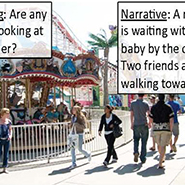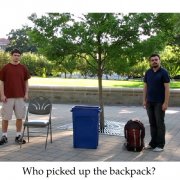We have constructed techniques for describing videos with natural language sentences. Building on this work, we are going beyond description to answering questions such as: What is the person on the left doing with the blue object? This work takes as input a natural-language question and produces a natural-language answer. We are striving to create an approach that will make it possible for a system to understand and answer a variety of questions, rather than constructing individual systems for each question type (who is there?, what are they doing?, where are they?, etc.).
Vision and Language
 The goal of this research is to combine vision with aspects of language and social cognition to obtain complex knowledge about the environment. To obtain a full understanding of visual scenes, computational models should be able to extract from the scene any meaningful information that a human observer can extract about actions, agents, goals, scenes and object configurations, social interactions, and more. We refer to this as the ‘Turing test for vision,’ i.e., the ability of a machine to use vision to answer a large and flexible set of queries about objects and agents in an image in a human-like manner. Queries might be about objects, their parts, and spatial relations between objects, actions, goals, and interactions. Understanding queries and formulating answers requires interactions between vision and natural language. Interpreting goals and interactions requires connections between vision and social cognition. Answering queries also requires task-dependent processing, i.e., different visual processes to achieve different goals.
The goal of this research is to combine vision with aspects of language and social cognition to obtain complex knowledge about the environment. To obtain a full understanding of visual scenes, computational models should be able to extract from the scene any meaningful information that a human observer can extract about actions, agents, goals, scenes and object configurations, social interactions, and more. We refer to this as the ‘Turing test for vision,’ i.e., the ability of a machine to use vision to answer a large and flexible set of queries about objects and agents in an image in a human-like manner. Queries might be about objects, their parts, and spatial relations between objects, actions, goals, and interactions. Understanding queries and formulating answers requires interactions between vision and natural language. Interpreting goals and interactions requires connections between vision and social cognition. Answering queries also requires task-dependent processing, i.e., different visual processes to achieve different goals.

